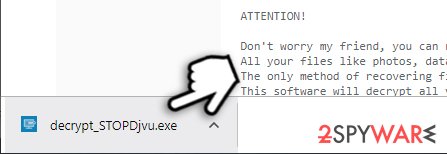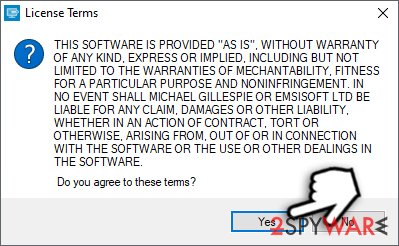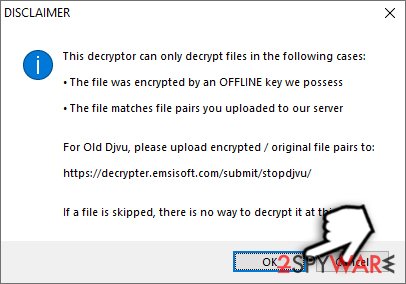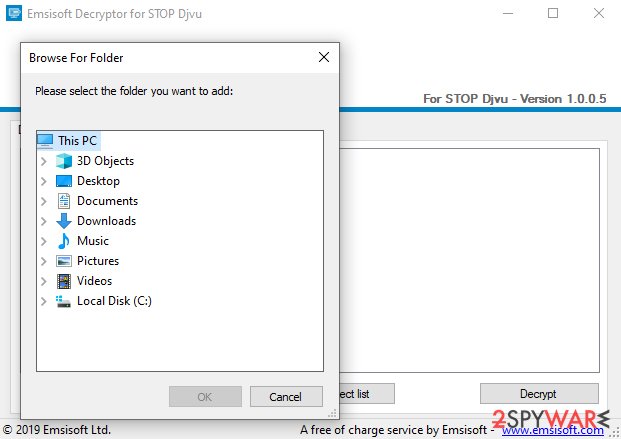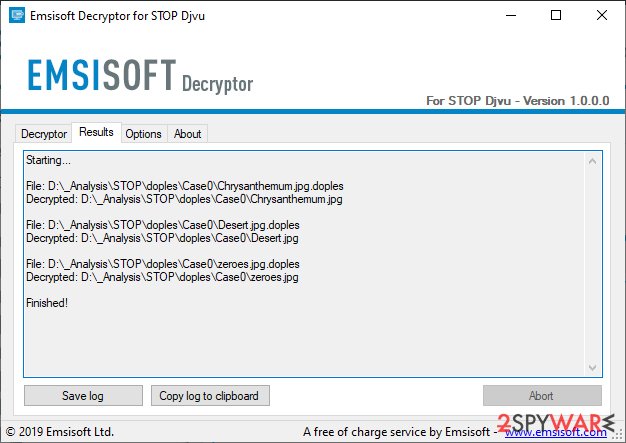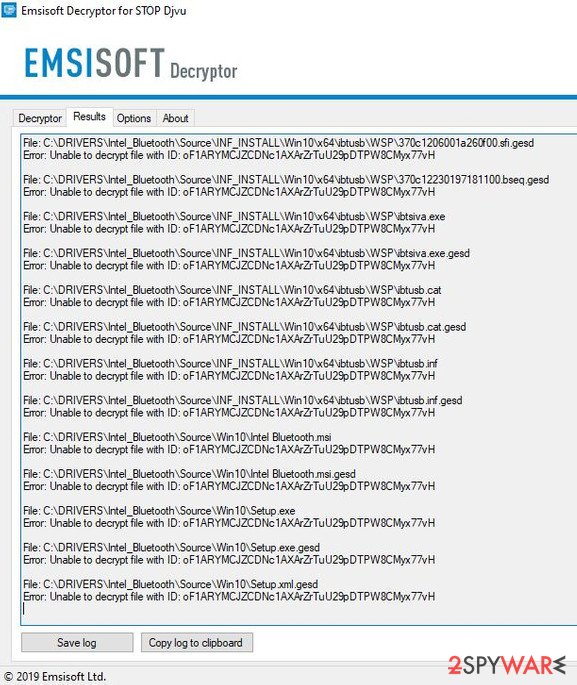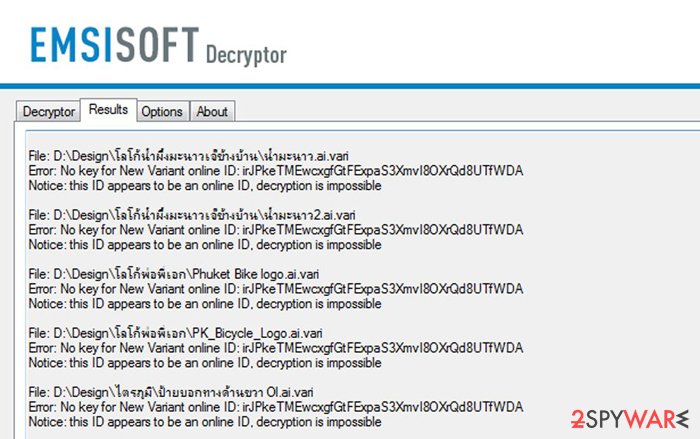Mmpa ransomware (Virus Removal Guide) - Quick Decryption Solution
Mmpa virus Removal Guide
What is Mmpa ransomware?
Mmpa ransomware is controlling files by locking them with the help of an encryption algorithm
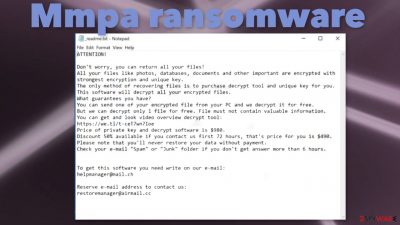
The main goal of the threat is to encrypt files[1] to have a reason to demand money from victims by delivering ransom messages in _readme.txt file that includes an offer for a 50% discount. Hackers behind the threat mark encoded data using the .mmpa file appendix and then demands a payment of $980 in Bitcoin cryptocurrency. To fake the trust with the victim, criminals offer to lower the amount by half in the first 72 hours. However, paying these people is never a recommended option.
Besides all these issues with images, documents, archives, and other data that gets locked during the encryption, Mmpa ransomware virus can delete files or turn off features useful for data recovery. Unfortunately, previous decryption tools do not work on the new versions in this family. You can rely on Emsisofts' Djvu decrypter only, but this tool works for variants based on offline IDs. It means that cryptovirus is not making a remote connection to the server when forming the unique victims' ID, so there are many identical ones. The latest versions like Vari, Lyli, Moss, Foqe are not decryptable. When it comes to file repairing, removing the threat, and relying on your data backups is the best solution.
| Name | Mmpa ransomware |
|---|---|
| Family | Djvu ransomware/ STOP virus |
| File extension | .mmpa |
| Ransom note | _readme.txt |
| Contact emails | Criminals offer to contact them via helpmanager@mail.ch or helpmanager@mail.ch |
| Distribution | The virus can spread using various methods that include malicious files or scripts on the page, website. The more common way of spreading Djvu versions – pirating sites and files found there. It mainly comes from game cheats, pirated Adobe packages, cracks[2] |
| Elimination | You should remove the ransomware right away before any file recovering options get considered. This ensures that you cannot damage files permanently |
| File recovery | You have limited options for file recovery because there are a few tools that can work for these newer versions of the ransomware. Media files can get restored with a particular file repair tool. Also, you might check the Djvu decryption tool developed for versions that rely on offline IDs |
| Repair | As for the system damage that threats like this can cause – you need a proper repairing tool like FortectIntego. The program might indicate altered files or corrupted pieces and fix them automatically |
Mmpa ransomware is a virus that attacks Windows computers by using various infiltration methods. The more common one for this family is a malicious file technique that drops the virus's payload once pirated software, cracks, and cheats get downloaded.
Once inside, it uses an encryption algorithm right away to lock up all documents, archives, videos, music, and other files. After that, the ransomware virus delivers a ransom note _readme.txt text file, which includes instructions on how to recover the encrypted data:
ATTENTION!
Don’t worry, you can return all your files!
All your files like photos, databases, documents and other important are encrypted with strongest encryption and unique key.
The only method of recovering files is to purchase decrypt tool and unique key for you.
This software will decrypt all your encrypted files.
What guarantees you have?
You can send one of your encrypted file from your PC and we decrypt it for free.
But we can decrypt only 1 file for free. File must not contain valuable information.
You can get and look video overview decrypt tool:
https://we.tl/t-gSEEREZ5tS
Price of private key and decrypt software is $980.
Discount 50% available if you contact us first 72 hours, that’s price for you is $490.
Please note that you’ll never restore your data without payment.
Check your e-mail “Spam” or “Junk” folder if you don’t get answer more than 6 hours.To get this software you need write on our e-mail:
helpmanager@mail.chReserve e-mail address to contact us:
restoremanager@firemail.ccYour personal ID:
According to Mmpa file virus authors, victims need to contact them via helpmanager@mail.ch or helpmanager@mail.ch email and provide their personal ID included in the ransom note and indicate each encoded device. Once that is done, users should receive further instructions to proceed with the payment, provided in Bitcoin cryptocurrency. Nonetheless, we do not recommend contacting the attackers because they might not deliver the required decryption tool.
The threat removal should be performed instead because the proper cleaning procedure can ensure that the machine is prepared for data recovery. SpyHunter 5Combo Cleaner or Malwarebytes should work great for the best results of eliminating malicious programs, malware, and other possible intruders. You need to double-check before other steps, so you are not risking losing your data permanently.
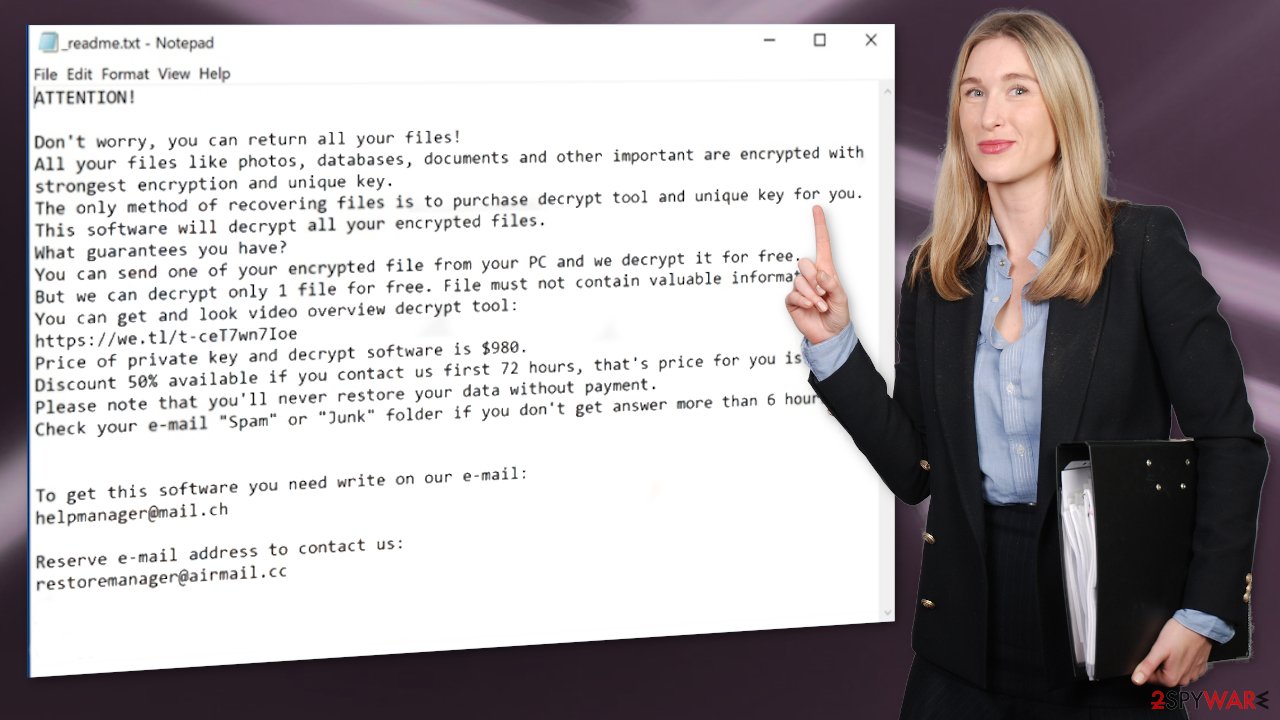
Limited solutions for .mmpa file recovery
Unfortunately, it is not easy to remove the ransomware, especially when you do not know when the threat managed to get on the system and when it achieves the needed goals of altering the system settings. Experts[3] note that there are issues with the recovery because the virus can disable security tools and damage files on the machine directly.
When you catch the file-locking virus, it can add a startup task and alter registry entries, so processes get launched continuously. It masks the process of encryption with the Windows Update procedure window, so you overlook the issue until those files get .mmpa extension.
From there, you have a few options only. Since the threat is related to money extortion, you shouldn't think about paying them at all. It is too risky, so we do not encourage to do so. You can expect decryption tools in the future, so saving some of the virus-related files, payload, encoded data, and storing that on the external drive can help later on. But it is not that easy to decrypt such threats as the Mmpa ransomware virus.
Third-party tools for file recovery might also work, but we cannot stress this enough – it is crucial to remove Mmpa virus fully before adding any backups, file copies, or recovered files on the machine. Clean virus damage with FortectIntego and repair those functions like ShadowExplorer before you try to get your files back to a normal state.
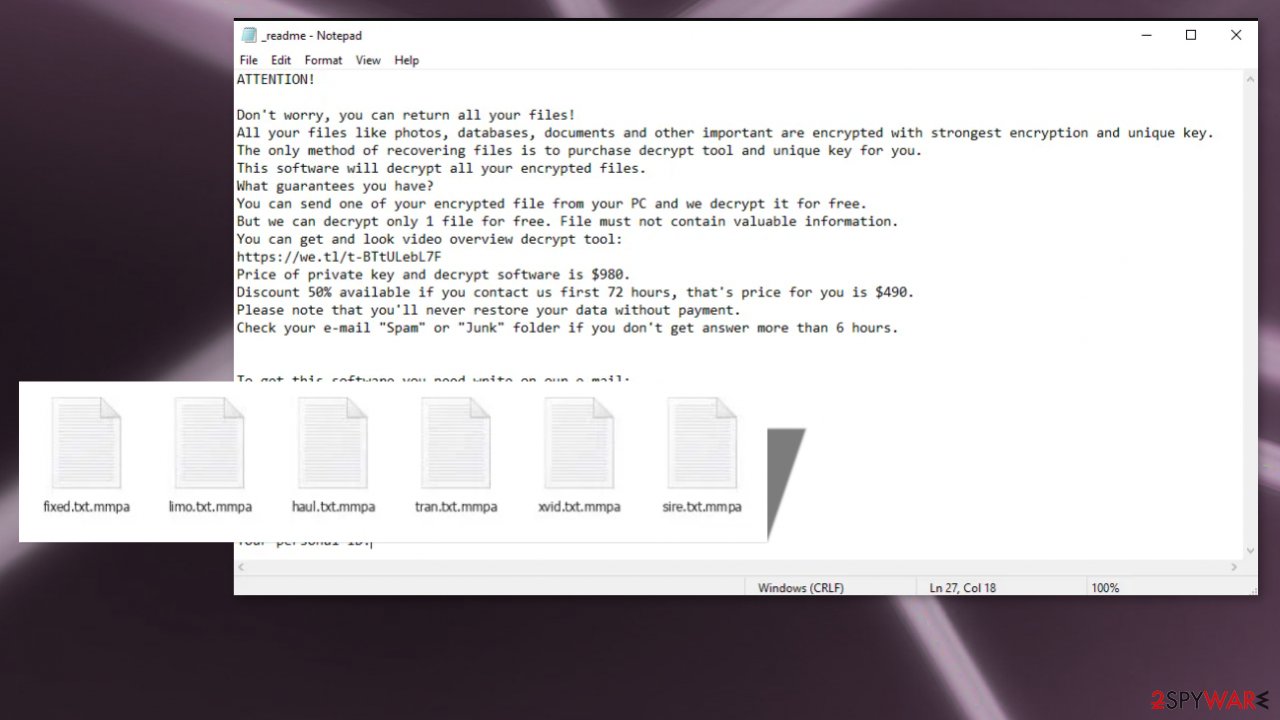
Use Emsisoft decryption tool for .Mmpa file recovery
Keep in mind that the notorious file virus might not be decryptable even for those who have their data encrypted with an offline ID for quite some time. One of the users who got encrypted with this variant needs to retrieve the offline key from the attackers and then share it with Emsisoft security researchers. Thus, if the tool does not work for you yet, you should wait some time and try it later.
Here's how to use it:
- Download Emsisoft's decryptor for Djvu [download link].
- Click on the decrypt_STOPDjvu.exe file at the bottom-left of your browser tab.

- Agree to License Terms.

- Click OK when Disclaimer window shows up.

- The Decryptor should automatically populate the encrypted file folders, although you can add them manually as well by pressing Add folder.

- The tool will run for some time and report whether your files can be decrypted.
From here, there are three outcomes that are available:
- “Decrypted!” will be shown under files that were decrypted successfully – they are now usable again.

- “Error: Unable to decrypt file with ID:” – this means that the offline keys for this version of Djvu has not been recovered yet (should try later).

- “This ID appears to be an online ID, decryption is impossible” – as description explains, decryption is not possible with the decryptor.

Mmpa ransomware virus termination and file restoring tips
The file virus – a threat that most likely got dropped on your machine when you downloaded a pirated program, crack of the licensed version software, game cheat. Torrent sites and other services like this are unsafe because criminals take advantage of such user behavior and plant malware.
It becomes difficult to remove Mmpa ransomware when it manages to plant other background processes, release trojans, or malware that records data. Decryption options are limited, so rely on SpyHunter 5Combo Cleaner or Malwarebytes and clear the infection yourself. Then you can search for additional help in the file restoring process.
Mmpa ransomware removal is not the same as file recovery. Anti-malware tools only clear intruders and cyber threats, but virus damage and other issues remain there. When you are sure that the virus got eliminated, you can enter the data backup device or find copies of files in the cloud. Of course, do not forget about virus damage and issues that can get fixed with FortectIntego full system check.
Getting rid of Mmpa virus. Follow these steps
Important steps to take before you begin malware removal
File encryption and ransomware infection are two independent processes (although the latter would not be possible without the former). However, it is important to understand that malware performs various changes within a Windows operating system, fundamentally changing the way it works.
IMPORTANT for those without backups! →
If you attempt to use security or recovery software immediately, you might permanently damage your files, and even a working decryptor then would not be able to save them.
Before you proceed with the removal instructions below, you should copy the encrypted files onto a separate medium, such as USB flash drive or SSD, and then disconnect them from your computer. Encrypted data does not hold any malicious code, so it is safe to transfer to other devices.
The instructions below might initially seem overwhelming and complicated, but they are not difficult to understand as long as you follow each step in the appropriate order. This comprehensive free guide will help you to handle the malware removal and data recovery process correctly.
If you have any questions, comments, or are having troubles with following the instructions, please do not hesitate to contact us via the Ask Us section.
IMPORTANT! →
It is vital to eliminate malware infection from the computer fully before starting the data recovery process, otherwise ransomware might re-encrypt retrieved files from backups repeatedly.
Isolate the infected computer
Some ransomware strains aim to infect not only one computer but hijack the entire network. As soon as one of the machines is infected, malware can spread via network and encrypt files everywhere else, including Network Attached Storage (NAS) devices. If your computer is connected to a network, it is important to isolate it to prevent re-infection after ransomware removal is complete.
The easiest way to disconnect a PC from everything is simply to plug out the ethernet cable. However, in the corporate environment, this might be extremely difficult to do (also would take a long time). The method below will disconnect from all the networks, including local and the internet, isolating each of the machines involved.
- Type in Control Panel in Windows search and press Enter
- Go to Network and Internet

- Click Network and Sharing Center

- On the left, pick Change adapter settings

- Right-click on your connection (for example, Ethernet), and select Disable

- Confirm with Yes.
If you are using some type of cloud storage you are connected to, you should disconnect from it immediately. It is also advisable to disconnect all the external devices, such as USB flash sticks, external HDDs, etc. Once the malware elimination process is finished, you can connect your computers to the network and internet, as explained above, but by pressing Enable instead.
Restore Windows "hosts" file to its original state
Some ransomware might modify Windows hosts file in order to prevent users from accessing certain websites online. For example, Djvu ransomware variants add dozens of entries containing URLs of security-related websites, such as 2-spyware.com. Each of the entries means that users will not be able to access the listed web addresses and will receive an error instead.
Here's an example of “hosts” file entries that were injected by ransomware:

In order to restore your ability to access all websites without restrictions, you should either delete the file (Windows will automatically recreate it) or remove all the malware-created entries. If you have never touched the “hosts” file before, you should simply delete it by marking it and pressing Shift + Del on your keyboard. For that, navigate to the following location:
C:\\Windows\\System32\\drivers\\etc\\

Restore files using data recovery software
Since many users do not prepare proper data backups prior to being attacked by ransomware, they might often lose access to their files permanently. Paying criminals is also very risky, as they might not fulfill the promises and never send back the required decryption tool.
While this might sound terrible, not all is lost – data recovery software might be able to help you in some situations (it highly depends on the encryption algorithm used, whether ransomware managed to complete the programmed tasks, etc.). Since there are thousands of different ransomware strains, it is immediately impossible to tell whether third-party software will work for you.
Therefore, we suggest trying regardless of which ransomware attacked your computer. Before you begin, several pointers are important while dealing with this situation:
- Since the encrypted data on your computer might permanently be damaged by security or data recovery software, you should first make backups of it – use a USB flash drive or another storage.
- Only attempt to recover your files using this method after you perform a scan with anti-malware software.
Install data recovery software
- Download Data Recovery Pro.
- Double-click the installer to launch it.

- Follow on-screen instructions to install the software.

- As soon as you press Finish, you can use the app.
- Select Everything or pick individual folders where you want the files to be recovered from.

- Press Next.
- At the bottom, enable Deep scan and pick which Disks you want to be scanned.

- Press Scan and wait till it is complete.

- You can now pick which folders/files to recover – don't forget you also have the option to search by the file name!
- Press Recover to retrieve your files.

Create data backups to avoid file loss in the future
One of the many countermeasures for home users against ransomware is data backups. Even if your Windows get corrupted, you can reinstall everything from scratch and retrieve files from backups with minimal losses overall. Most importantly, you would not have to pay cybercriminals and risk your money as well.
Therefore, if you have already dealt with a ransomware attack, we strongly advise you to prepare backups for future use. There are two options available to you:
- Backup on a physical external drive, such as a USB flash drive or external HDD.
- Use cloud storage services.
The first method is not that convenient, however, as backups need to constantly be updated manually – although it is very reliable. Therefore, we highly advise choosing cloud storage instead – it is easy to set up and efficient to sustain. The problem with it is that storage space is limited unless you want to pay for the subscription.
Using Microsoft OneDrive
OneDrive is a built-in tool that comes with every modern Windows version. By default, you get 5 GB of storage that you can use for free. You can increase that storage space, but for a price. Here's how to setup backups for OneDrive:
- Click on the OneDrive icon within your system tray.
- Select Help & Settings > Settings.

- If you don't see your email under the Account tab, you should click Add an account and proceed with the on-screen instructions to set yourself up.

- Once done, move to the Backup tab and click Manage backup.

- Select Desktop, Documents, and Pictures, or a combination of whichever folders you want to backup.
- Press Start backup.

After this, all the files that are imported into the above-mentioned folders will be automatically backed for you. If you want to add other folders or files, you have to do that manually. For that, open File Explorer by pressing Win + E on your keyboard, and then click on the OneDrive icon. You should drag and drop folders you want to backup (or you can use Copy/Paste as well).
Using Google Drive
Google Drive is another great solution for free backups. The good news is that you get as much as 15GB for free by choosing this storage. There are also paid versions available, with significantly more storage to choose from.
You can access Google Drive via the web browser or use a desktop app you can download on the official website. If you want your files to be synced automatically, you will have to download the app, however.
- Download the Google Drive app installer and click on it.

- Wait a few seconds for it to be installed.

- Now click the arrow within your system tray – you should see Google Drive icon there, click it once.

- Click Get Started.

- Enter all the required information – your email/phone, and password.

- Now pick what you want to sync and backup. You can click on Choose Folder to add additional folders to the list.
- Once done, pick Next.

- Now you can select to sync items to be visible on your computer.
- Finally, press Start and wait till the sync is complete. Your files are now being backed up.
Manual removal using Safe Mode
Important! →
Manual removal guide might be too complicated for regular computer users. It requires advanced IT knowledge to be performed correctly (if vital system files are removed or damaged, it might result in full Windows compromise), and it also might take hours to complete. Therefore, we highly advise using the automatic method provided above instead.
Step 1. Access Safe Mode with Networking
Manual malware removal should be best performed in the Safe Mode environment.
Windows 7 / Vista / XP
- Click Start > Shutdown > Restart > OK.
- When your computer becomes active, start pressing F8 button (if that does not work, try F2, F12, Del, etc. – it all depends on your motherboard model) multiple times until you see the Advanced Boot Options window.
- Select Safe Mode with Networking from the list.

Windows 10 / Windows 8
- Right-click on Start button and select Settings.

- Scroll down to pick Update & Security.

- On the left side of the window, pick Recovery.
- Now scroll down to find Advanced Startup section.
- Click Restart now.

- Select Troubleshoot.

- Go to Advanced options.

- Select Startup Settings.

- Press Restart.
- Now press 5 or click 5) Enable Safe Mode with Networking.

Step 2. Shut down suspicious processes
Windows Task Manager is a useful tool that shows all the processes running in the background. If malware is running a process, you need to shut it down:
- Press Ctrl + Shift + Esc on your keyboard to open Windows Task Manager.
- Click on More details.

- Scroll down to Background processes section, and look for anything suspicious.
- Right-click and select Open file location.

- Go back to the process, right-click and pick End Task.

- Delete the contents of the malicious folder.
Step 3. Check program Startup
- Press Ctrl + Shift + Esc on your keyboard to open Windows Task Manager.
- Go to Startup tab.
- Right-click on the suspicious program and pick Disable.

Step 4. Delete virus files
Malware-related files can be found in various places within your computer. Here are instructions that could help you find them:
- Type in Disk Cleanup in Windows search and press Enter.

- Select the drive you want to clean (C: is your main drive by default and is likely to be the one that has malicious files in).
- Scroll through the Files to delete list and select the following:
Temporary Internet Files
Downloads
Recycle Bin
Temporary files - Pick Clean up system files.

- You can also look for other malicious files hidden in the following folders (type these entries in Windows Search and press Enter):
%AppData%
%LocalAppData%
%ProgramData%
%WinDir%
After you are finished, reboot the PC in normal mode.
Finally, you should always think about the protection of crypto-ransomwares. In order to protect your computer from Mmpa and other ransomwares, use a reputable anti-spyware, such as FortectIntego, SpyHunter 5Combo Cleaner or Malwarebytes
How to prevent from getting ransomware
Access your website securely from any location
When you work on the domain, site, blog, or different project that requires constant management, content creation, or coding, you may need to connect to the server and content management service more often. The best solution for creating a tighter network could be a dedicated/fixed IP address.
If you make your IP address static and set to your device, you can connect to the CMS from any location and do not create any additional issues for the server or network manager that needs to monitor connections and activities. VPN software providers like Private Internet Access can help you with such settings and offer the option to control the online reputation and manage projects easily from any part of the world.
Recover files after data-affecting malware attacks
While much of the data can be accidentally deleted due to various reasons, malware is one of the main culprits that can cause loss of pictures, documents, videos, and other important files. More serious malware infections lead to significant data loss when your documents, system files, and images get encrypted. In particular, ransomware is is a type of malware that focuses on such functions, so your files become useless without an ability to access them.
Even though there is little to no possibility to recover after file-locking threats, some applications have features for data recovery in the system. In some cases, Data Recovery Pro can also help to recover at least some portion of your data after data-locking virus infection or general cyber infection.
- ^ Encryption. Wikipedia. The free encyclopedia.
- ^ Filip Truta. Beware of New Wiper Malware Distributed through Free Software / Crack Sites. Securityboulevard. Threat reports.
- ^ Virusai. Virusai. Spyware related news.
